Abstract
A retrospective cohort study was carried out to test the hypothesis that children born at term with cerebral palsy with signs of neurological dysfunction preceded by depression at birth (termed neonatal encephalopathy) differ from those without such signs in the frequency of antenatal and perinatal factors, and in the severity and characteristics of their impairment and disability. The study was carried out in the area covered by Oxford Regional Health Authority. Antenatal, intrapartum, neonatal factors, and the later clinical status of the two groups of children were used as the main outcome measures. Although most maternal and antenatal characteristics were similar in the two groups, the mothers of children with a history of neonatal encephalopathy were more likely to be primigravidae (odds ratio (OR) 2.0; 95% confidence interval (CI) 1.0 to 4.3) and to have a pregnancy of greater than 41 weeks' gestation (OR 3.5; 95% CI 1.0 to 12.1). Intrapartum complications were more frequent in the neonatal encephalopathy group: meconium staining of the amniotic fluid (OR 3.5; 95% CI 1.5 to 7.8), an ominous first stage cardiotocograph (OR 10.2; 95% CI 2.9 to 36.4), with a longer median duration of abnormality (200 v 48 minutes). At 5 years of age those with neonatal encephalopathy were more likely to have developed spastic quadriplegia (OR 4.8; 95% CI 2.2 to 10.5), to have visual impairment (OR 3.0; 95% CI 1.0 to 8.6), and to be non-walking (OR 4.0; 95% CI 1.8 to 8.8) than those without neonatal encephalopathy. Children with cerebral palsy who were born at term and have neonatal encephalopathy are more likely to have had signs of intrapartum asphyxia and are more likely to have a more severe form of cerebral palsy than those without a history of neonatal encephalopathy. Although this group represents only one in 10 of all cases of cerebral palsy, some of these may be obstetrically preventable.
Full text
PDF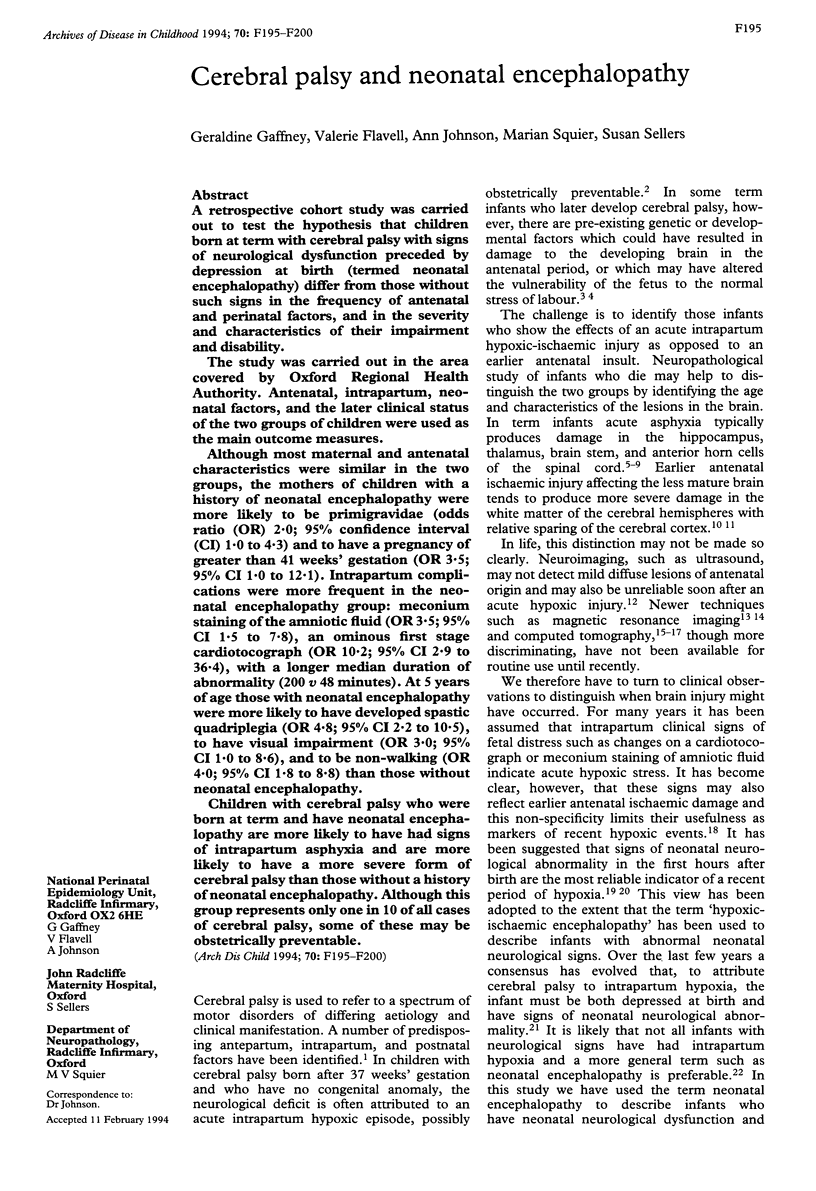
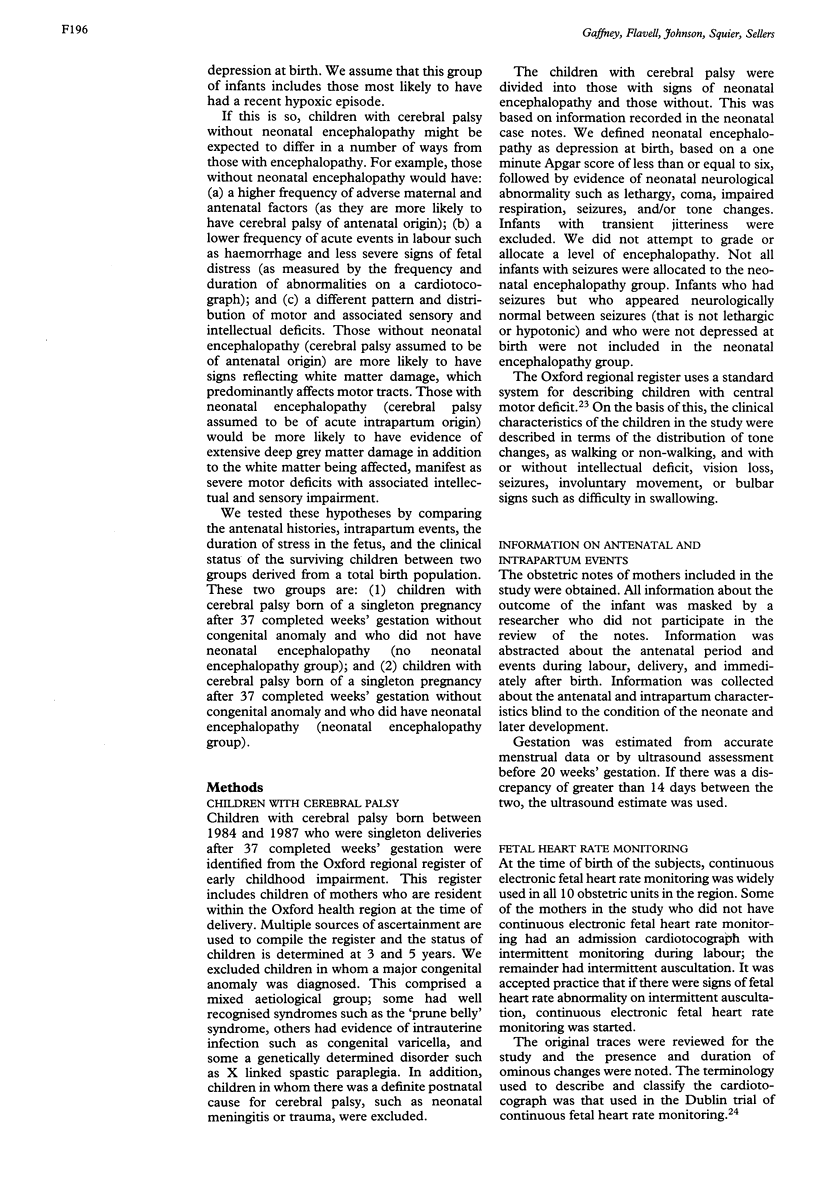
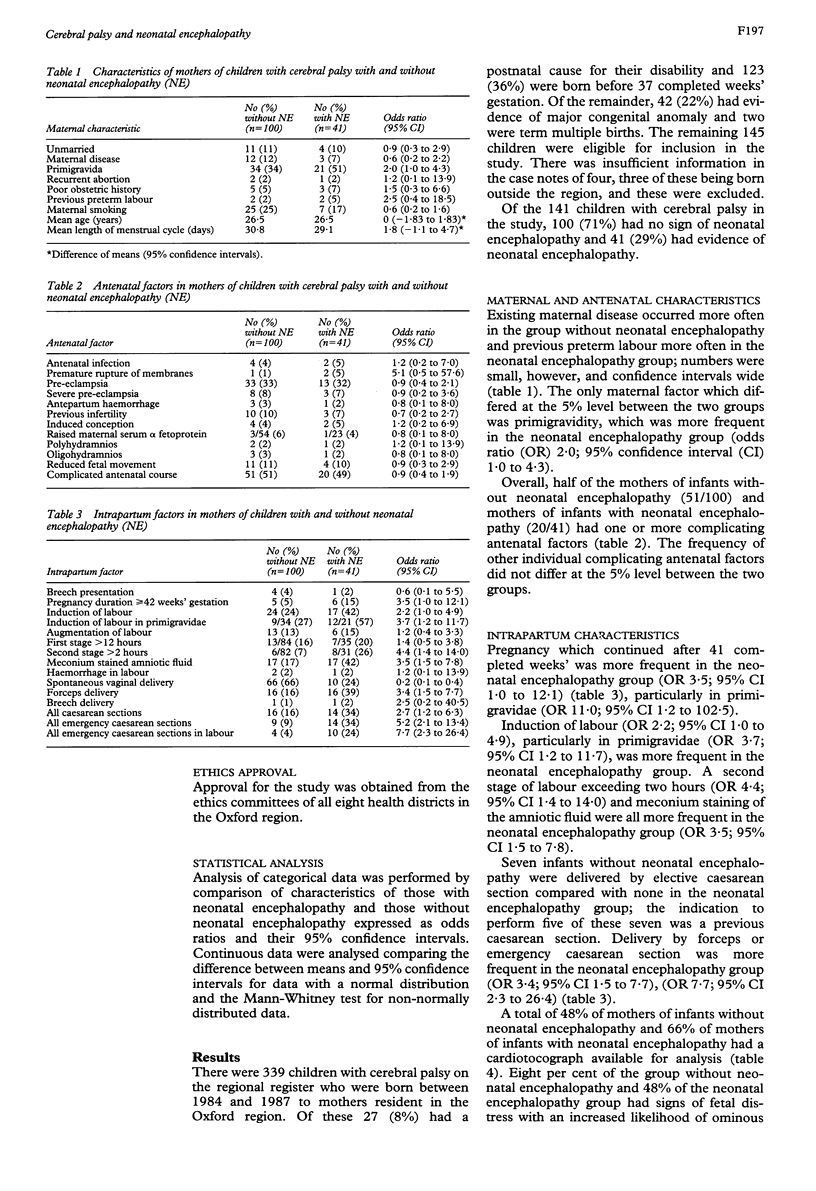
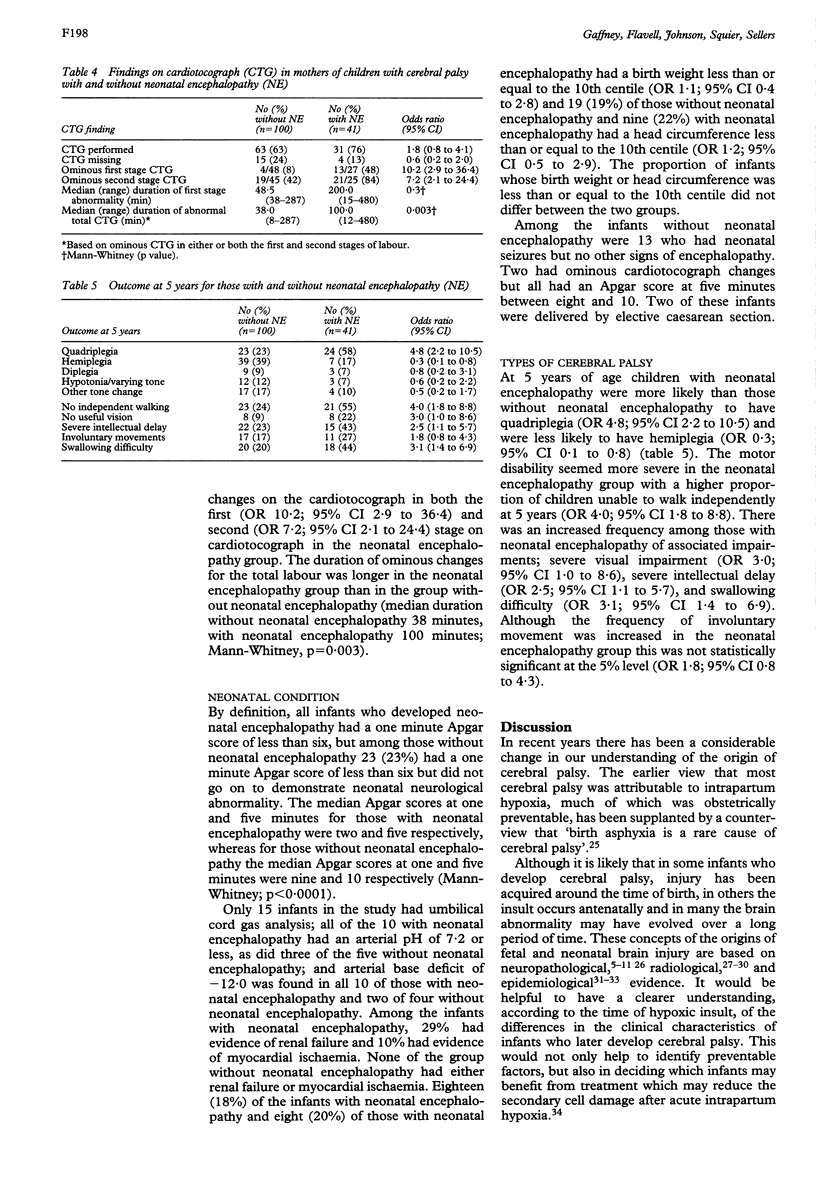
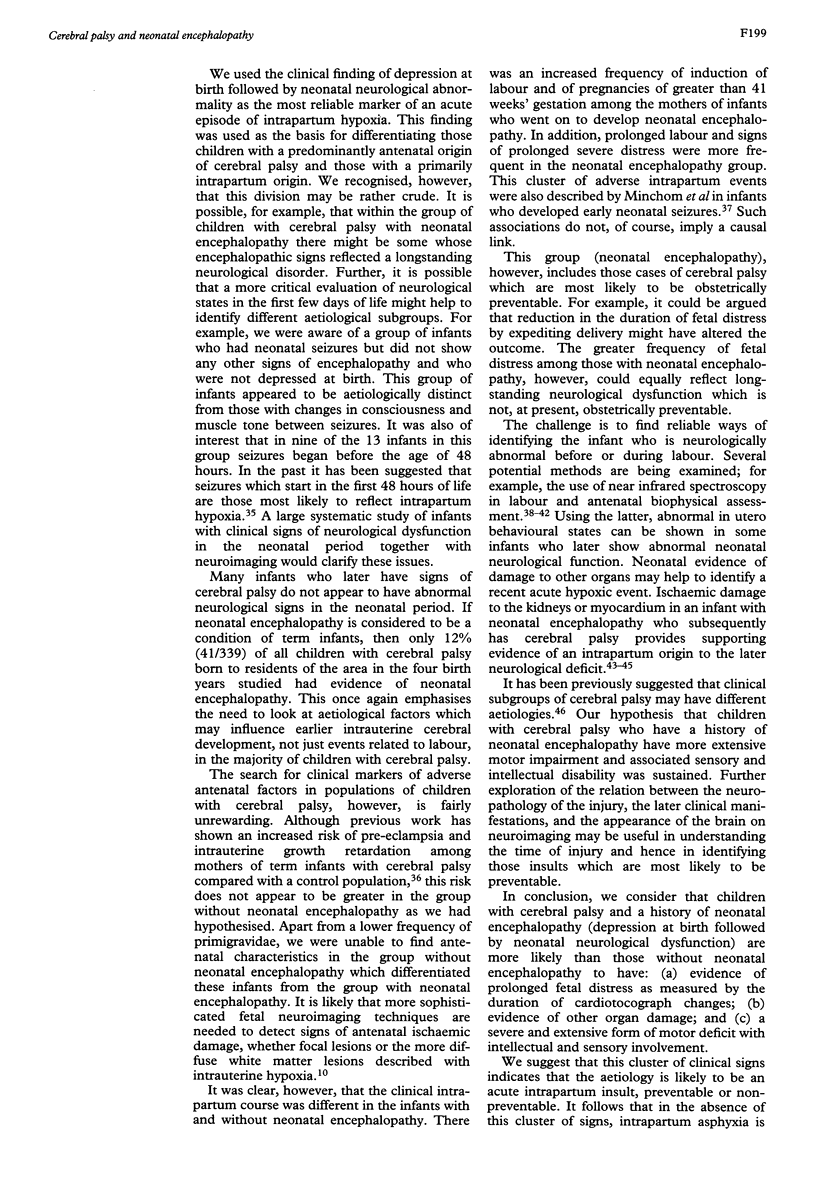
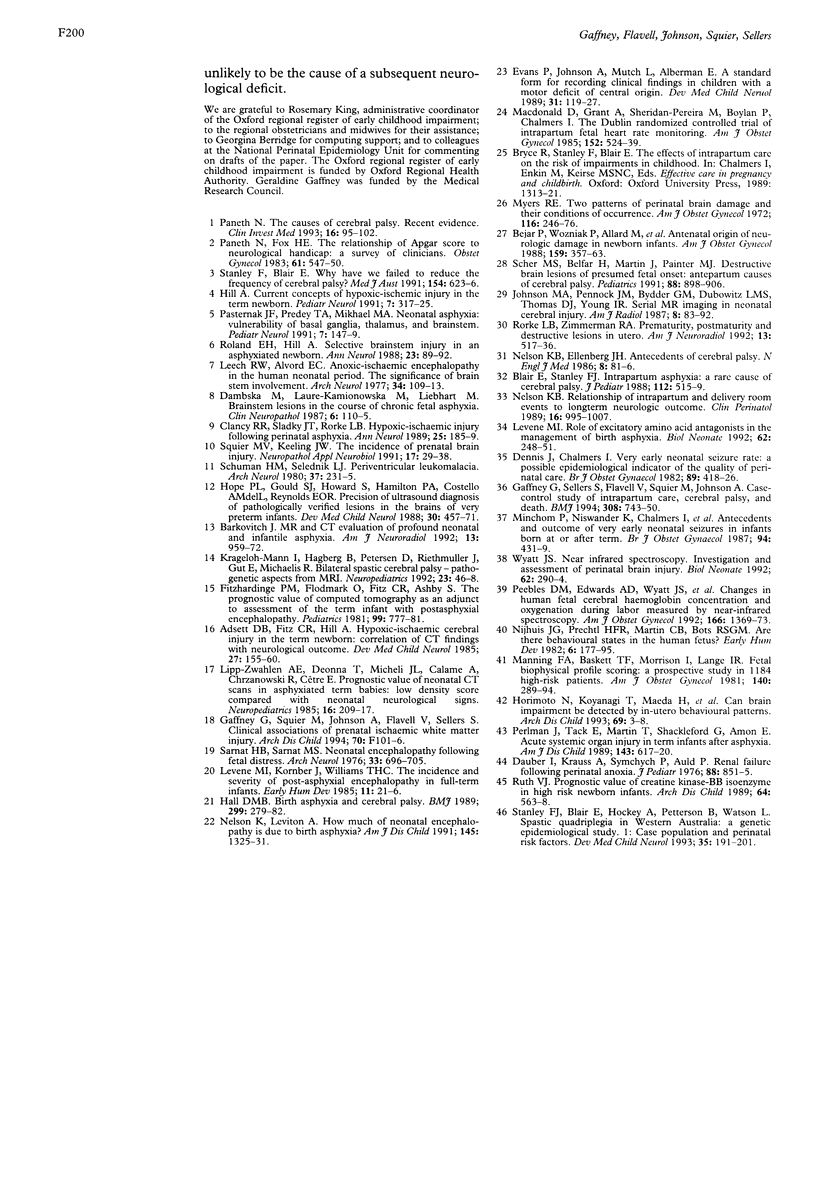
Selected References
These references are in PubMed. This may not be the complete list of references from this article.
- Adsett D. B., Fitz C. R., Hill A. Hypoxic-ischaemic cerebral injury in the term newborn: correlation of CT findings with neurological outcome. Dev Med Child Neurol. 1985 Apr;27(2):155–160. doi: 10.1111/j.1469-8749.1985.tb03764.x. [DOI] [PubMed] [Google Scholar]
- Barkovich A. J. MR and CT evaluation of profound neonatal and infantile asphyxia. AJNR Am J Neuroradiol. 1992 May-Jun;13(3):959–975. [PMC free article] [PubMed] [Google Scholar]
- Bejar R., Wozniak P., Allard M., Benirschke K., Vaucher Y., Coen R., Berry C., Schragg P., Villegas I., Resnik R. Antenatal origin of neurologic damage in newborn infants. I. Preterm infants. Am J Obstet Gynecol. 1988 Aug;159(2):357–363. doi: 10.1016/s0002-9378(88)80084-x. [DOI] [PubMed] [Google Scholar]
- Blair E., Stanley F. J. Intrapartum asphyxia: a rare cause of cerebral palsy. J Pediatr. 1988 Apr;112(4):515–519. doi: 10.1016/s0022-3476(88)80161-6. [DOI] [PubMed] [Google Scholar]
- Clancy R. R., Sladky J. T., Rorke L. B. Hypoxic-ischemic spinal cord injury following perinatal asphyxia. Ann Neurol. 1989 Feb;25(2):185–189. doi: 10.1002/ana.410250213. [DOI] [PubMed] [Google Scholar]
- Dambska M., Laure-Kamionowska M., Liebhart M. Brainstem lesions in the course of chronic fetal asphyxia. Clin Neuropathol. 1987 May-Jun;6(3):110–115. [PubMed] [Google Scholar]
- Dauber I. M., Krauss A. N., Symchych P. S., Auld P. A. Renal failure following perinatal anoxia. J Pediatr. 1976 May;88(5):851–855. doi: 10.1016/s0022-3476(76)81130-4. [DOI] [PubMed] [Google Scholar]
- Dennis J., Chalmers I. Very early neonatal seizure rate: a possible epidemiological indicator of the quality of perinatal care. Br J Obstet Gynaecol. 1982 Jun;89(6):418–426. doi: 10.1111/j.1471-0528.1982.tb03630.x. [DOI] [PubMed] [Google Scholar]
- Fitzhardinge P. M., Flodmark O., Fitz C. R., Ashby S. The prognostic value of computed tomography as an adjunct to assessment of the term infant with postasphyxial encephalopathy. J Pediatr. 1981 Nov;99(5):777–781. doi: 10.1016/s0022-3476(81)80410-6. [DOI] [PubMed] [Google Scholar]
- Gaffney G., Sellers S., Flavell V., Squier M., Johnson A. Case-control study of intrapartum care, cerebral palsy, and perinatal death. BMJ. 1994 Mar 19;308(6931):743–750. doi: 10.1136/bmj.308.6931.743. [DOI] [PMC free article] [PubMed] [Google Scholar]
- Hall D. M. Birth asphyxia and cerebral palsy. BMJ. 1989 Jul 29;299(6694):279–282. doi: 10.1136/bmj.299.6694.279. [DOI] [PMC free article] [PubMed] [Google Scholar]
- Hill A. Current concepts of hypoxic-ischemic cerebral injury in the term newborn. Pediatr Neurol. 1991 Sep-Oct;7(5):317–325. doi: 10.1016/0887-8994(91)90060-x. [DOI] [PubMed] [Google Scholar]
- Hope P. L., Gould S. J., Howard S., Hamilton P. A., Costello A. M., Reynolds E. O. Precision of ultrasound diagnosis of pathologically verified lesions in the brains of very preterm infants. Dev Med Child Neurol. 1988 Aug;30(4):457–471. doi: 10.1111/j.1469-8749.1988.tb04773.x. [DOI] [PubMed] [Google Scholar]
- Horimoto N., Koyanagi T., Maeda H., Satoh S., Takashima T., Minami T., Nakano H. Can brain impairment be detected by in utero behavioural patterns? Arch Dis Child. 1993 Jul;69(1 Spec No):3–8. doi: 10.1136/adc.69.1_spec_no.3. [DOI] [PMC free article] [PubMed] [Google Scholar]
- Johnson M. A., Pennock J. M., Bydder G. M., Dubowitz L. M., Thomas D. J., Young I. R. Serial MR imaging in neonatal cerebral injury. AJNR Am J Neuroradiol. 1987 Jan-Feb;8(1):83–92. [PMC free article] [PubMed] [Google Scholar]
- Krägeloh-Mann I., Hagberg B., Petersen D., Riethmüller J., Gut E., Michaelis R. Bilateral spastic cerebral palsy--pathogenetic aspects from MRI. Neuropediatrics. 1992 Feb;23(1):46–48. doi: 10.1055/s-2008-1071311. [DOI] [PubMed] [Google Scholar]
- Leech R. W., Alvord E. C., Jr Anoxic-ischemic encephalopathy in the human neonatal period. The significance of brain stem involvement. Arch Neurol. 1977 Feb;34(2):109–113. doi: 10.1001/archneur.1977.00500140063013. [DOI] [PubMed] [Google Scholar]
- Levene M. L., Kornberg J., Williams T. H. The incidence and severity of post-asphyxial encephalopathy in full-term infants. Early Hum Dev. 1985 May;11(1):21–26. doi: 10.1016/0378-3782(85)90115-x. [DOI] [PubMed] [Google Scholar]
- Levene M. Role of excitatory amino acid antagonists in the management of birth asphyxia. Biol Neonate. 1992;62(4):248–251. doi: 10.1159/000243878. [DOI] [PubMed] [Google Scholar]
- Lipp-Zwahlen A. E., Deonna T., Micheli J. L., Calame A., Chrzanowski R., Cêtre E. Prognostic value of neonatal CT scans in asphyxiated term babies: low density score compared with neonatal neurological signs. Neuropediatrics. 1985 Nov;16(4):209–217. doi: 10.1055/s-2008-1059539. [DOI] [PubMed] [Google Scholar]
- MacDonald D., Grant A., Sheridan-Pereira M., Boylan P., Chalmers I. The Dublin randomized controlled trial of intrapartum fetal heart rate monitoring. Am J Obstet Gynecol. 1985 Jul 1;152(5):524–539. doi: 10.1016/0002-9378(85)90619-2. [DOI] [PubMed] [Google Scholar]
- Manning F. A., Baskett T. F., Morrison I., Lange I. Fetal biophysical profile scoring: a prospective study in 1,184 high-risk patients. Am J Obstet Gynecol. 1981 Jun 1;140(3):289–294. doi: 10.1016/0002-9378(81)90275-1. [DOI] [PubMed] [Google Scholar]
- Minchom P., Niswander K., Chalmers I., Dauncey M., Newcombe R., Elbourne D., Mutch L., Andrews J., Williams G. Antecedents and outcome of very early neonatal seizures in infants born at or after term. Br J Obstet Gynaecol. 1987 May;94(5):431–439. doi: 10.1111/j.1471-0528.1987.tb03121.x. [DOI] [PubMed] [Google Scholar]
- Myers R. E. Two patterns of perinatal brain damage and their conditions of occurrence. Am J Obstet Gynecol. 1972 Jan 15;112(2):246–276. doi: 10.1016/0002-9378(72)90124-x. [DOI] [PubMed] [Google Scholar]
- Nelson K. B., Ellenberg J. H. Antecedents of cerebral palsy. Multivariate analysis of risk. N Engl J Med. 1986 Jul 10;315(2):81–86. doi: 10.1056/NEJM198607103150202. [DOI] [PubMed] [Google Scholar]
- Nelson K. B. Relationship of intrapartum and delivery room events to long-term neurologic outcome. Clin Perinatol. 1989 Dec;16(4):995–1007. [PubMed] [Google Scholar]
- Nijhuis J. G., Prechtl H. F., Martin C. B., Jr, Bots R. S. Are there behavioural states in the human fetus? Early Hum Dev. 1982 Apr;6(2):177–195. doi: 10.1016/0378-3782(82)90106-2. [DOI] [PubMed] [Google Scholar]
- Paneth N., Fox H. E. The relationship of Apgar score to neurologic handicap: a survey of clinicians. Obstet Gynecol. 1983 May;61(5):547–550. [PubMed] [Google Scholar]
- Paneth N. The causes of cerebral palsy. Recent evidence. Clin Invest Med. 1993 Apr;16(2):95–102. [PubMed] [Google Scholar]
- Pasternak J. F., Predey T. A., Mikhael M. A. Neonatal asphyxia: vulnerability of basal ganglia, thalamus, and brainstem. Pediatr Neurol. 1991 Mar-Apr;7(2):147–149. doi: 10.1016/0887-8994(91)90014-c. [DOI] [PubMed] [Google Scholar]
- Peebles D. M., Edwards A. D., Wyatt J. S., Bishop A. P., Cope M., Delpy D. T., Reynolds E. O. Changes in human fetal cerebral hemoglobin concentration and oxygenation during labor measured by near-infrared spectroscopy. Am J Obstet Gynecol. 1992 May;166(5):1369–1373. doi: 10.1016/0002-9378(92)91606-b. [DOI] [PubMed] [Google Scholar]
- Perlman J. M., Tack E. D., Martin T., Shackelford G., Amon E. Acute systemic organ injury in term infants after asphyxia. Am J Dis Child. 1989 May;143(5):617–620. doi: 10.1001/archpedi.1989.02150170119037. [DOI] [PubMed] [Google Scholar]
- Roland E. H., Hill A., Norman M. G., Flodmark O., MacNab A. J. Selective brainstem injury in an asphyxiated newborn. Ann Neurol. 1988 Jan;23(1):89–92. doi: 10.1002/ana.410230115. [DOI] [PubMed] [Google Scholar]
- Rorke L. B., Zimmerman R. A. Prematurity, postmaturity, and destructive lesions in utero. AJNR Am J Neuroradiol. 1992 Mar-Apr;13(2):517–536. [PMC free article] [PubMed] [Google Scholar]
- Ruth V. J. Prognostic value of creatine kinase BB-isoenzyme in high risk newborn infants. Arch Dis Child. 1989 Apr;64(4):563–568. doi: 10.1136/adc.64.4.563. [DOI] [PMC free article] [PubMed] [Google Scholar]
- Sarnat H. B., Sarnat M. S. Neonatal encephalopathy following fetal distress. A clinical and electroencephalographic study. Arch Neurol. 1976 Oct;33(10):696–705. doi: 10.1001/archneur.1976.00500100030012. [DOI] [PubMed] [Google Scholar]
- Scher M. S., Belfar H., Martin J., Painter M. J. Destructive brain lesions of presumed fetal onset: antepartum causes of cerebral palsy. Pediatrics. 1991 Nov;88(5):898–906. [PubMed] [Google Scholar]
- Shuman R. M., Selednik L. J. Periventricular leukomalacia. A one-year autopsy study. Arch Neurol. 1980 Apr;37(4):231–235. doi: 10.1001/archneur.1980.00500530069011. [DOI] [PubMed] [Google Scholar]
- Squier M., Keeling J. W. The incidence of prenatal brain injury. Neuropathol Appl Neurobiol. 1991 Feb;17(1):29–38. doi: 10.1111/j.1365-2990.1991.tb00691.x. [DOI] [PubMed] [Google Scholar]
- Stanley F. J., Blair E., Hockey A., Petterson B., Watson L. Spastic quadriplegia in Western Australia: a genetic epidemiological study. I: Case population and perinatal risk factors. Dev Med Child Neurol. 1993 Mar;35(3):191–201. doi: 10.1111/j.1469-8749.1993.tb11624.x. [DOI] [PubMed] [Google Scholar]
- Stanley F. J., Blair E. Why have we failed to reduce the frequency of cerebral palsy? Med J Aust. 1991 May 6;154(9):623–626. doi: 10.5694/j.1326-5377.1991.tb121226.x. [DOI] [PubMed] [Google Scholar]
- Wyatt J. S. Near infrared spectroscopy. Investigation and assessment of perinatal brain injury. Biol Neonate. 1992;62(4):290–294. doi: 10.1159/000243884. [DOI] [PubMed] [Google Scholar]


